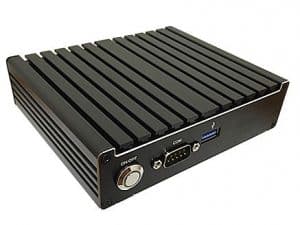
NUC Form Factor Boards
Posted on July 12, 2023
The ATX form factor is good for PCs, but commercial settings usually need smaller embedded computers. And while the ITX form factor is good for that, what about the even smaller NUC?
NUC – The Smallest Form Factor for Computers
The main draw of NUC is the size. The Next Unit of Computing (NUC) has been designed to fit in a 4 x 4-inch space, with a thickness of just 1.5 inches.
This makes it even smaller than the mini-ITX form factor, making it even easier to mount in enclosed spaces. In commercial settings, this enables computers to be integrated seamlessly into the environment.
Applications like billing systems or digital signboards can benefit greatly from this, as the embedded systems powering them need to be small and discreet. The industrial space is even more sensitive toward size, with industrial automation and surveillance systems requiring a compact footprint.
How Does it Compare to Other Form Factors?
PC form factors vary mostly based on size. The larger form factors offer more flexibility and power but are largely unnecessary for industrial applications. The smaller form factors have fewer expansion slots but are more well-suited for building specialized boards.
ATX is the most common form factor in the desktop computing space, with the micro-ATX board dominating most builds. It offers enough extensibility to accommodate any and all needs, along with plenty of heat sinks and fans for cooling.
After that, we get the ITX form factor, with its mini-ITX version being the most popular. This cuts down the number of PCI lanes as well as memory slots but still leaves enough leeway for some customizability. Most high-performance industrial PCs utilize the ITX form factor.
Features of NUC Systems
The NUC platform was introduced and is maintained by Intel. This means only Intel manufactures NUC-compatible motherboards. By design, all essential features are integrated right into the motherboard, saving you from having to install a bunch of expansion cards. All that is needed is a storage module, a good enclosure, and the system is ready for use. The limited size of the NUC form factor means that any peripherals have to be small and limited. Most NUC boards only attach a storage unit – either eMMC or full-sized SATA – and a wireless connectivity card if the application demands it.
The enclosures generally rely on fanless cooling, since the power draw and the size footprint of a fan would be too much for this form factor. This makes them ideal for both indoor and outdoor deployment.
Examples of NUC Boards
Here at Global American, we have released a number of NUC boards suitable for all kinds of applications.
The JBC420U91 mini fanless PC, for example, features a full-sized mSATA board and even a limited PCIe express slot for connecting a Wi-Fi card. And thanks to fanless cooling and a long lifecycle (through 2029), it can be used to power long-term applications without any major upgrades or repairs required.
For even more power there is the JBC330U10. It packs an Intel Tiger Lake Core i5 processor along with an NVMe M.2 slot for high-speed SSDs into the diminutive NUC frame. Combined with its wireless connectivity and 2.5 GbE LAN support, the JBC330U10 is the ideal system for network computing or surveillance setups.
Is NUC the Future?
Embedded computing has always prioritized miniaturization. Computers meant to operate in commercial or industrial environments need to have a small footprint, especially when they are meant to be slotted into a discreet enclosure.
New Unit of Computing (NUC) systems offer the perfect solution to these constraints. They are the smallest form factor without going for low-performance mobile components, making them the most powerful size-efficient computers in the market.
With their specialized Intel motherboards, these boards can power a variety of embedded applications without needing a bunch of expansion cards. This also gives them surprisingly long lifecycles, as the board can be used without any any major software or hardware updates for many years.
